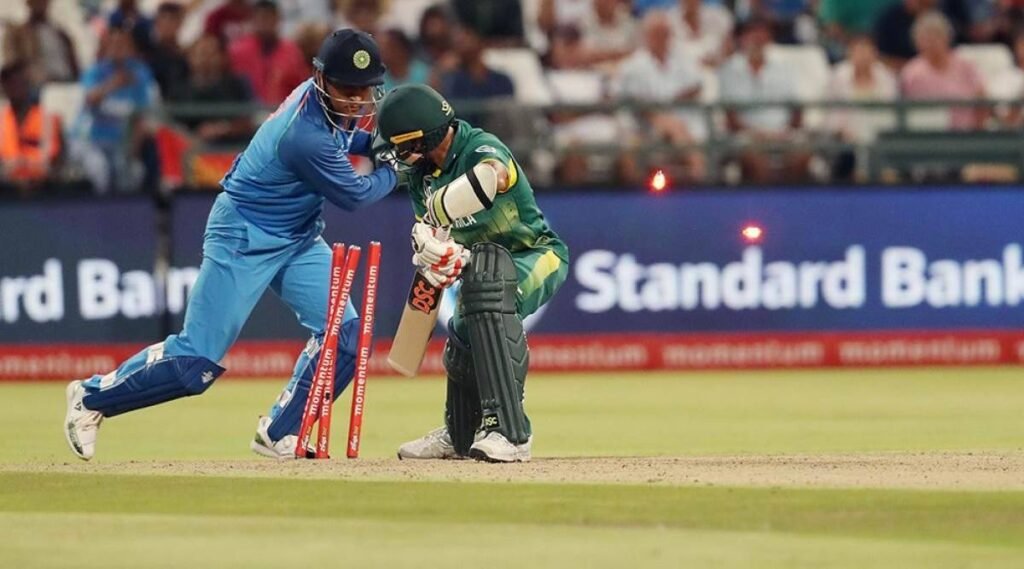Wicketkeeping
Wicketkeeping is an art. It requires a lot of concentration and focuses because the wicketkeeper is the only player who receives the ball maximum times in the match. He must be alert and attentive throughout the game. If you want to stump a batsman or run out a batsman, then there is a technique for it. But, there are guidelines that need to be followed.
Players use different techniques that are quicker and simpler because they have to do all the hard work in a fraction of seconds. If they don’t use a proper technique, then they can miss catches, stumping, or run-outs and can get injuries as well. Wicketkeeping is the only player on the fielding side who wears gloves and pads and has to sit in a squatting position throughout the match.
It requires a lot of mental and physical strength. The squatting is done in order to get a good view of the ball which helps in collecting the ball quickly. It becomes really difficult for a keeper to keep wickets in the longer formats. There must be a proper wicketkeeper in the team. Otherwise, it could leak runs behind the wicket.
The player who stands behind the wicket in the game of cricket is known as a wicketkeeper. His role is to take a catch or stump the batsman or run out a batsman. Now, days wicket-keeper has also been given the duty of judging the DRS (Umpire Decision Review System) review. He can share his views and can suggest to the skipper( captain) whether to take the DRS or not. Because they have the best visibility and can judge it easily in comparison with the other players.
The harsh reality is that it is a batsman’s game. If a batsman scores a half-century or century everyone remembers it. But, no one will remember if a wicket-keeper takes five catches in a match. That is why it is considered a thankless job. However, if he drops a catch, then everyone remembers it.
There is a lot of training for your legs and strength training exercises, catching practice, diving catches, running, and sprinting which need to be done. Everyone has to prepare for the training as per their body. The more you practice, the better you will become. Being a wicketkeeper, you can’t wait for the opportunity to come your way. You have to be creative and take initiative in order to make things happen. That is why wicketkeeping is an art.
It is important to maintain a head position and balance. Otherwise, you won’t be able to collect the ball. If a bowler appeals for LBW, all the players turn up towards the wicketkeeper because he is standing behind the wicket and he is in the best position to judge whether it is out or not. Then, he can share his views with the captain. It is really difficult to keep wickets on a turning track or on the 4th or 5th day in the longer formats.
The keeper must be observant and need to stand accordingly for the bouncy wickets or low bounce wickets and need to keep in mind the direction of the wind. He needs to be prepared for the fast bowlers, medium pace, or spinners. Because the different technique is required for different bowlers. Some people find it easier to keep wickets on a turning track or some people like flat tracks. It depends on person to person.
More opportunity arises for the wicketkeeper in the turning tracks. Because spinners came into the picture and produce more edges for the keeper or the person standing at the slips. So, the keeper needs to be super alert. Because the ball can come at any time and you cannot miss the opportunities that are coming your way. There is a saying that if you drop catches, you lose matches.
A wicketkeeper and a batsman have few similarities like stance and balance. It needs to be correct in order to judge gather the ball quickly and can stump out the batsman. For that, he needs to do a lot of hard work. The more he practices, the better he will become. If a keeper is technically correct, then he does not need to dive much. But, if his technique is not good, then he would have to dive a lot. Because he is facing difficulties in judging the ball and due to which he would not be able to gather it correctly. But, if he dives a lot, then it might save him.
If a keeper faces a back issue or pain in the neck, then it indicates that he is not using the right technique. He needs to work on his technique if he wants to correct it. So, he does not face any issues. In case if he is finding it difficult to move, then he needs to work on his stance. That will help in improving Wicketkeeping skills.
The most underrated partnership is between the wicketkeeper and the bowler. On many occasions, both the keeper and the bowler make plans for the batsman. And they sometimes bowl outside the off-stump or outside the leg stump. So that they can create mistakes from the batsman so that they can dismiss him.
Sometimes, a bowler bowls a bad delivery down the leg side. But, the keeper needs to try and make sure that he saves the ball from going to the boundary through his dive. It will give a boost to the bowler if he saves the boundary.
The trust factor is the most important thing in this partnership. If a bowler won’t discuss the plans with the keeper, then it might be possible that even the keeper misses the stumping chance or catch. A wicketkeeper needs to have an understanding of which bowler will bowl which delivery. And what variations the bowler has and when he is going to use it.
Featured Image


